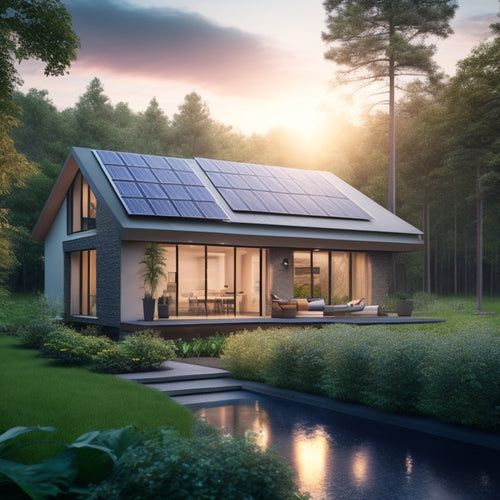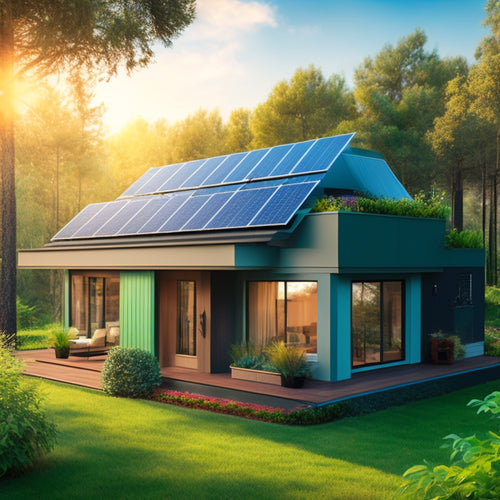
What Can Live Energy Tracking Reveal About Your Home?
Share
Live energy tracking reveals the hidden patterns and inefficiencies in your home's energy usage, providing a detailed understanding of how, when, and where you're consuming energy. It uncovers standby power consumption, identifies energy-hungry appliances, and exposes daily usage cycles, including morning spikes and afternoon surges. You'll uncover seasonal fluctuations, opportunities for energy savings, and areas for improvement, such as inefficient lighting and inadequate insulation. By tracking your energy usage in real-time, you'll be able to make data-driven decisions to reduce waste, cut costs, and minimize your environmental footprint - and that's just the beginning of what you can learn about your home.
Key Takeaways
- Live energy tracking reveals hidden energy wastage from appliances and devices, even when turned off or in standby mode.
- It identifies energy consumption hotspots and areas of inefficiency, such as inadequate insulation and aging HVAC systems.
- Live energy tracking provides real-time data on daily energy usage cycles, including morning and evening spikes, to inform energy-saving strategies.
- It uncovers seasonal fluctuations in energy consumption, highlighting opportunities for adjustments and optimization during weather changes.
- Live energy tracking detects standby power consumption and energy-hungry appliances, enabling targeted upgrades and replacements for increased efficiency.
Hidden Energy Wasters Uncovered
Across your home, numerous devices and appliances are quietly draining energy, often without your knowledge or consent. These hidden energy wasters can add up quickly, increasing your energy bills and reducing your freedom to allocate resources as you see fit.
In fact, did you know that renewable energy sources like solar and wind power can greatly reduce greenhouse gas emissions and operating costs, making them a sustainable alternative for powering your home and electric vehicles?
Conducting energy audits can help identify these energy-sucking culprits, allowing you to take control of your energy usage. By pinpointing areas of inefficiency, you can implement targeted efficiency upgrades, such as installing energy-efficient light bulbs or optimizing your HVAC system.
Real-Time Usage Patterns Exposed
By identifying hidden energy wasters, you've taken the first step towards regaining control over your energy consumption.
Now, it's time to explore deeper into your usage trends. Live energy tracking provides real-time data on your energy usage patterns, revealing behavioral observations that can help you optimize your consumption.
You'll see when and where energy is being used, allowing you to identify opportunities to adjust your habits and reduce waste. For instance, you might notice that your energy usage spikes during peak hours or that certain appliances are consuming more energy than expected.
Additionally, incorporating solar-powered energy solutions can further reduce your reliance on the grid and carbon footprint.
With this information, you can make informed decisions to adjust your energy usage, freeing yourself from unnecessary costs and environmental impact.
Appliance Efficiency Revealed
You're likely aware that your appliances consume energy in different patterns, but do you know which ones are the most inefficient?
By analyzing your energy consumption patterns, you'll uncover hidden energy wasters and identify devices that waste energy during idle time, giving you a clear illustration of where to optimize.
For instance, did you know that DC Fast Charging Stations can have installation costs ranging from $5,000 to $50,000+, and that solar-powered stations can save you $500 to $2,000+ annually?
This information will enable you to make targeted changes to reduce your energy bills and environmental impact.
Energy Consumption Patterns
Since understanding your energy consumption patterns is crucial to identifying areas for improvement, let's examine the details of appliance efficiency.
Your energy behavior and consumption habits play a significant role in determining your overall energy usage. By tracking your energy consumption patterns, you'll gain awareness into which appliances are driving your energy costs.
For instance, you might find that your refrigerator is consuming more energy than expected, indicating an opportunity to upgrade to a more efficient model. Alternatively, you might uncover that your energy consumption spikes during certain times of the day, revealing opportunities to adjust your usage habits.
Additionally, optimizing your solar panel array design, including the proper tilt and orientation, can also impact your energy production and consumption.
Hidden Energy Wasters
Within your home, numerous appliances operate behind the scenes, consuming energy without your knowledge. These hidden energy wasters can be identified through energy audits, revealing opportunities for behavioral changes and efficiency upgrades.
By leveraging smart technology and energy monitoring, you can uncover areas of inefficiency and make data-driven decisions to reduce your environmental impact. Conducting regular energy audits evaluating fleet energy needs can help you pinpoint opportunities to reduce reliance on fossil fuels and optimize routes to minimize energy consumption.
-
Inefficient appliances: Outdated or poorly maintained appliances can waste significant amounts of energy, driving up your energy bills and carbon footprint.
-
Standby power consumption: Many devices continue to draw power even when turned off, accounting for up to 10% of your total energy usage.
-
Home automation oversights: Improperly configured or malfunctioning home automation systems can lead to unnecessary energy waste, negating potential cost savings and environmental benefits.
Device Idle Time
As you identify hidden energy wasters, another important contributor to energy inefficiency comes into focus: device idle time. This refers to the energy consumed by devices when they're turned off but still plugged in. You may be surprised to find that many devices continue to draw power even when not in use, known as "vampire" or "standby" power.
| Device | Idle Power Consumption (W) |
|---|---|
| TV | 5-10 |
| Computer | 2-5 |
| Phone Charger | 0.5-2 |
Effective device management involves idle detection to identify which devices are wasting energy. By taking control of device idle time, you can optimize your energy usage and reduce your carbon footprint. This level of understanding is essential for achieving energy independence and minimizing your environmental impact.
Energy Consumption Hotspots Identified
You've likely suspected that some appliances or areas in your home are consuming more energy than they should, but now you'll pinpoint the exact culprits.
Your energy tracking system will expose hidden power hogs, reveal usage patterns, and identify energy wastage, giving you a clear understanding of where your energy is being spent.
Hidden Power Hogs Exposed
Five common appliances in your home are likely consuming more energy than you think. With live energy tracking, you can identify these hidden power hogs and take control of your energy consumption.
-
Idle electronics: TVs, computers, and other electronics continue to draw power when turned off but still plugged in.
-
Refrigerator and freezer: These appliances are always running, accounting for a significant portion of your energy bill.
-
Water heater: Heating water for showers, dishes, and laundry adds up quickly.
Usage Patterns Revealed
Your home's energy usage patterns can be a complex puzzle, but live energy tracking helps you identify the pieces that don't quite fit, revealing energy consumption hotspots that drive up your utility bills.
By analyzing your usage trends, you'll uncover consumption habits that impact your energy costs. Live energy tracking provides real-time data, enabling you to pinpoint when and where energy is being wasted.
You'll realize which appliances, lighting, and electronics are contributing to your high energy bills. For instance, you might find that your energy usage spikes during peak hours or that certain rooms in your home consume more energy than others.
With this significant understanding, you can make informed decisions to optimize your energy usage and reduce your utility bills.
Energy Wastage Identified
Live energy tracking illuminates the path to energy efficiency by pinpointing areas of wastage in your home.
You can identify energy consumption hotspots, which are often hidden from view, and take corrective action to reduce your energy bills.
With live energy tracking, you can conduct a virtual energy audit, eliminating the need for costly on-site energy audits.
This smart technology helps you:
-
Detect standby power consumption: Identify appliances that continue to draw power even when turned off.
-
Uncover inefficient lighting: Pinpoint areas where lighting is excessive or inefficient, allowing you to optimize your lighting setup.
-
Identify energy-hungry appliances: Uncover which appliances are consuming the most energy, enabling you to replace them with more efficient alternatives.
Daily Energy Usage Cycles
One key aspect of understanding your home's energy usage is identifying daily energy usage cycles. By analyzing your energy usage trends, you can pinpoint specific times of the day when your energy consumption is highest or lowest. This information helps you optimize your daily consumption patterns, making adjustments to reduce waste and save energy.
| Time of Day | Energy Consumption |
|---|---|
| Morning (7am-10am) | High (lights, appliances, heating/cooling) |
| Afternoon (12pm-4pm) | Medium (computers, TVs, refrigeration) |
| Evening (7pm-10pm) | High (lights, appliances, entertainment systems) |
Peak Energy Demand Periods
When you analyze your home's energy usage patterns, you'll likely notice two distinct peak energy demand periods: morning spikes and afternoon energy surges.
During these periods, your energy consumption increases markedly, often due to the simultaneous use of multiple high-power appliances.
Understanding these peak periods is essential to optimizing your energy usage and reducing your overall energy expenditure.
Morning Spikes
During the morning hours, typically between 6:00 and 10:00 am, your home experiences its highest energy demand periods, known as morning spikes. This is due to your morning routines, which trigger a surge in energy consumption.
Your energy habits, such as turning on lights, brewing coffee, and charging devices, all contribute to this peak demand.
Here are three key factors driving morning spikes:
-
Lighting: As you wake up and start your day, you turn on lights, which account for a significant portion of your morning energy usage.
-
Appliance usage: Your morning routine likely involves using appliances like toasters, blenders, and coffee makers, which consume a lot of energy.
-
Device charging: As you get ready for the day, you plug in your devices, such as phones, laptops, and tablets, to charge, adding to the morning energy spike.
Afternoon Energy Surges
Your home's energy usage doesn't slow down after the morning rush; instead, it experiences another peak demand period in the afternoon.
This surge in energy consumption is often attributed to increased appliance usage as you start preparing dinner or do laundry. Additionally, afternoon sunlight can also contribute to this peak, as it heats up your home and triggers the need for air conditioning or fans.
Live energy tracking reveals that these afternoon energy surges can be just as significant as morning spikes, with some homes experiencing a 10-20% increase in energy demand.
Energy Losses and Inefficiencies
You're likely aware that your home's energy efficiency isn't always ideal. Energy losses and inefficiencies can be significant, and live energy tracking can help identify areas for improvement.
By analyzing your energy consumption patterns, you can pinpoint where energy is being wasted and make informed decisions to optimize your energy use.
Here are three key areas where energy losses and inefficiencies often occur:
-
Inadequate insulation and air leaks: Heat escapes through poorly insulated walls, floors, and ceilings, while air leaks around doors and windows let heated or cooled air out.
-
Inefficient appliances and lighting: Outdated or poorly maintained appliances and lighting fixtures consume more energy than necessary.
-
Poorly designed or aging HVAC systems: Inefficient heating, ventilation, and air conditioning systems can lead to significant energy losses.
Home Energy Scorecard Analysis
Take control of your home's energy efficiency by diving into a home energy scorecard analysis.
This thorough review provides an extensive overview of your energy consumption, identifying areas for improvement and opportunities for cost savings. By combining data from energy audits, smart meters, and monitoring systems, you'll gain real-time understandings into your energy usage.
Compare your consumption to benchmarks and reveal where efficiency upgrades can make the most impact. Implement sustainable practices and consider renewable sources to reduce your carbon footprint.
Make behavioral changes and track their effectiveness, refining your approach as you go. With a home energy scorecard analysis, you'll access the full potential of your home's energy efficiency, enjoying the freedom that comes with being in control of your energy costs.
Seasonal Energy Usage Fluctuations
During seasonal changes, your home's energy usage undergoes significant fluctuations. By tracking your energy usage, you can identify these fluctuations and understand what drives them.
Here are three key factors that influence seasonal energy usage fluctuations:
-
Weather impacts: Temperature changes, humidity, and precipitation patterns affect your heating and cooling needs, leading to variations in energy consumption.
-
Holiday variations: Changes in occupancy patterns and lifestyle shifts during holidays can impact your energy usage, such as increased lighting and cooking during winter holidays.
-
Utility rate changes: Seasonal changes in utility rates can also influence your energy costs, making it essential to monitor and adjust your energy usage accordingly.
Opportunities for Energy Savings
Seasonal energy usage fluctuations offer a prime opportunity to identify areas for energy savings. By analyzing your live energy tracking data, you can pinpoint where energy is being wasted and take corrective action.
Consider investing in smart thermostats, energy audits, or renewable alternatives to optimize your energy usage. Behavioral adjustments, such as turning off lights and appliances when not in use, can also make a significant impact.
Look into energy rebates and incentives for insulation upgrades, efficient lighting, and other energy-saving measures. With demand response and monitoring tools, you can take control of your energy management and make data-driven decisions to reduce your energy consumption.
Frequently Asked Questions
Can I Track Energy Usage When I'm Not at Home?
You can remotely monitor your energy usage when you're not at home, gaining understanding into your energy habits and identifying areas for improvement, thanks to advanced live energy tracking systems that provide real-time data access.
How Accurate Are the Energy Tracking Readings?
You're stuck in traffic, but your energy usage isn't; with real-time monitoring, you're freed from uncertainty, as data accuracy reveals the truth - every watt, every minute, ensuring your home's energy efficiency is always on track, not stuck in the dark.
Can I Customize the Energy Tracking System for My Home?
You can tailor the energy tracking system to your unique needs by setting custom settings that align with your user preferences, allowing you to prioritize specific appliances or areas of your home for a more detailed understanding.
Are Energy Tracking Systems Compatible With All Appliances?
You're wondering if those fancy smart appliances will sync with your energy tracking system - rest assured, most modern appliances are compatible, and you'll gain useful information into their energy efficiency, enabling you to optimize their performance.
Do Energy Tracking Systems Require Professional Installation?
You'll find that some energy tracking systems require professional installation, but many offer user-friendly options, allowing you to DIY with ease, granting you freedom from dependencies and control over your energy monitoring setup.
Related Posts
-

3 Best Eco-Grants for Home Energy Upgrades
You're eligible for various eco-grants that can help you cut down on energy bills and reduce your carbon footprint by...
-

Why Merge Earth's Heat With Sun's Energy?
You're about to utilize the full potential of renewable energy by combining the Earth's natural heat with the Sun's a...
-

3 Green HVAC Filters for Solar-Powered Homes
When outfitting your solar-powered home with an HVAC system, you'll want to choose filters that align with your commi...


